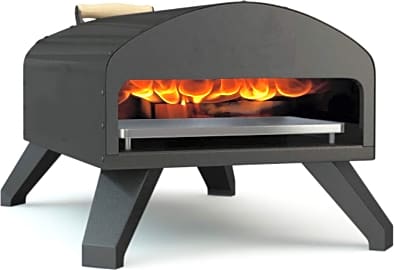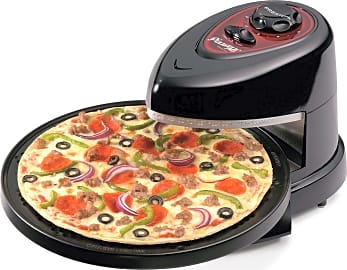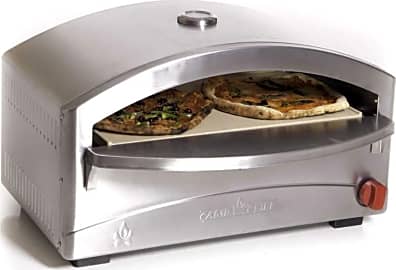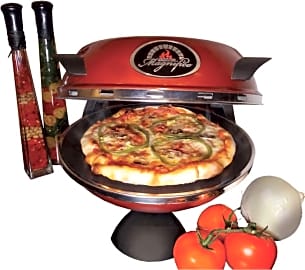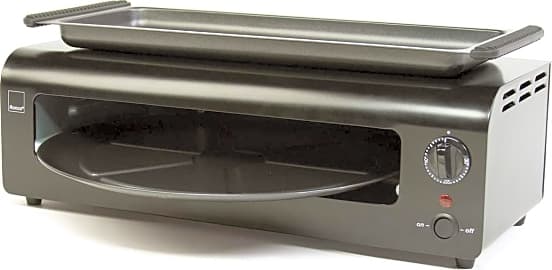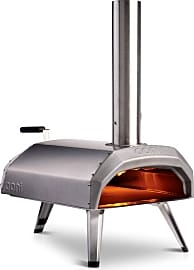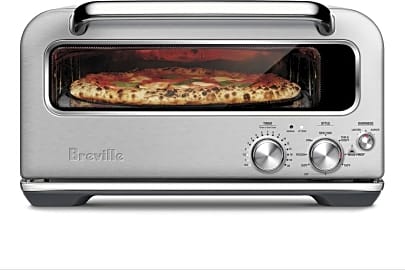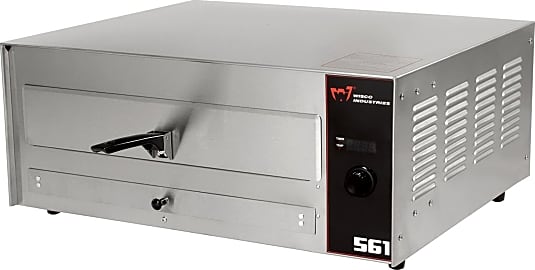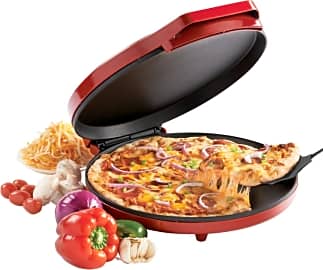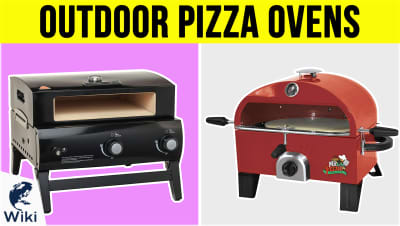The 10 Best Home Pizza Ovens

This wiki has been updated 41 times since it was first published in September of 2015. Few foods are as universally loved as pizza, but conventional ovens don't get hot enough to do the dish justice. If you'd like to make your own pies, these picks can help you replicate restaurant-style dishes using a variety of fuel sources. We've included high-powered outdoor models that can cook in as little as 60 seconds as well as countertop options for indoor convenience. When users buy our independently chosen editorial choices, we may earn commissions to help fund the Wiki.
Editor's Notes
November 04, 2020:
Home pizza making continues to gain in popularity, and home oven options remain impressive. The Gozney Roccbox is a relative newcomer, but it has quickly earned a following for its strong heat retention and impressive feature set. Another new entry is the expensive Breville Pizzaiolo, which may be the most authentic way to bake a pie without stepping outside. Home ovens don't necessarily need to be expensive — if you're okay with lower temperatures, models like the Presto Pizzazz Plus and Forno Magnifico get the job done for relatively little. We still like Ooni's line of ovens, but availability issues meant that we had to remove several from our list. The Wisco 421 has been phased out, but it's been replaced by the more powerful Wisco 561. Aside from choosing between countertop and outdoor models, the biggest choice a home chef faces is fuel. Propane is convenient and reliable, but some purists will want that classic wood-fired flavor. The good news is that you don't necessarily have to choose one or the other — models like the Ooni Karu and Bertello Outdoor are compatible with both. Most of our picks come with pans or pizza stones, but you'll want to pick up a pizza peel if one isn't included. And of course, you'll need a good pizza cutter to enjoy your oven-fresh creations.
November 08, 2019:
There's an impressive range of awesome tools for making pizza in the comfort of your own home. From one of the most popular brands, the Ooni 3, Ooni Pro, and Ooni Koda all work very quickly, and the first two can provide authentic wood-fired flavor. The only issue with the 3 and the Pro are that they must be used outdoors their chimneys are pretty large, but the units overall are actually relatively lightweight and portable. The Koda is one of the most stylish and might just be the talk of your backyard party, though it is restricted to using gas as fuel. Another of the best options for classic, wood-fired results is the Bertello Napoli.
If you'd rather stay inside or avoid the smelliest of burning fuels, that shouldn't be a problem. The Pizzacraft Pizzeria Pronto and Camp Chef Italia both connect to standard propane tanks and are perfectly effective; in fact, the Pizzacraft is one of the easiest-to-use gas-powered models you'll find. There are also a handful of incredibly convenient indoor models such as the Presto Pizzazz Plus, Tabletop Pizzarette, and Betty Crocker 2958CR. They aren't quite as classic as the others, but they're fun and easy to use.
Whichever you do end up with, you'll definitely need a good pizza peel, and we'd highly recommend a rocker knife for cutting everything into the appropriate-size pieces.
Special Honors
Pizzamaking.com If you're looking for inspiration and community on your pizza-making journey, look no further — this forum is an excellent resource. You'll find discussions of equipment, techniques, recipes, and more, from hobbyists as well as professional chefs. pizzamaking.com
Biolite PizzaDome Bundle For adventurous pie-makers, this campground-ready model burns firewood and has an integrated power-storage battery to charge phones and devices. Its dome has a built-in thermometer, and the whole kit folds down for easy transportation. bioliteenergy.com
Types Of Pizza Ovens
Home pizza ovens come in a lot of different varieties, so there should be one to fit every type of kitchen and personal taste.
Home pizza ovens come in a lot of different varieties, so there should be one to fit every type of kitchen and personal taste. There is no hard and fast rule regarding which type cooks the best pizza, though some are better suited to certain styles of pizza. For example, open rotating style ovens are not as suitable for cooking thick crust Neapolitan pizza, but they excel at thin crust varieties.
Convection ovens are commonly used to cook pizzas in home and commercial settings. They offer a number of benefits, including a low cost, and quick, efficient cooking. Convection ovens are most often electrical, though some gas models are available. Convection provides even heating throughout the pizza, so the dough and the toppings cook at a similar pace. This even heating does have some drawbacks, though, as the cheese and toppings may be finished cooking before the dough, making it difficult to get very crispy crust without the addition of a pizza stone.
Revolving tray pizza ovens are a relatively new style of cooking pizza. They are designed to slowly spin a pizza between two heating elements, one above and one below. The rotating nature ensures every inch of the pizza receives the same amount of heat, reducing the chance of having dark spots on the dough. Rotating tray pizza ovens are often small enough to fit on most home countertops, but often cannot get hot enough for very crispy crusts.
Traditional countertop pizza ovens are designed specifically for home use. They will often have a stainless steel exterior, giving them somewhat of an industrial look that some people love, while others may not. Just like traditional commercial pizza ovens, they have a front-loading door that opens to insert a pizza. Many models also feature a pullout tray, making inserting and removing pizzas easier.
For those who prefer to use their grill or stovetop as the main heat source, there are models available which are designed to sit on top of these units. These will usually feature a top, bottom, and sides, to reflect heat towards the pizza, with just a small opening in the front to insert a pie.
Finally, there are clam-shell countertop varieties. These are often very compact, making them ideal for those with minimal storage space. Most will have either a non-stick baking pan or ceramic pizza stone on the inside. Some may include deep dish inserts for making thicker pizzas as well. Unfortunately, most clam-shell countertop models do not feature adjustable thermostats. They do tend to cook at very high temperatures, making them ideal for achieving extra crispy crusts.
Why Pizzas Need Such High Heat
When cooking pizza, the pressure of expanding gasses inside the dough is vital to the volume achieved in the end product. To understand why this happens, one must first understand the internal structure of dough. After kneading the dough, it is left with layers of protein-reinforced starch. The fermentation of sugars and starches within the dough leaves CO2 and alcohol as a byproduct.
The fermentation of sugars and starches within the dough leaves CO2 and alcohol as a byproduct.
When the dough is put into a hot oven, three types of heat transfer occur, convection, conductive, and radiant. As the heat is transferred into the dough, the remaining moisture, alcohol, and CO2 inside of it begin to expand rapidly. This creates the lift and puffiness found in cooked pizza dough. As this happens, the outer skin of the dough hardens and becomes crispy.
If the heat of the oven is not intense enough, the gases won't expand rapidly enough before the crust hardens. This will result in a pizza dough that is too dense and crumbly. Heat transfer and thermal mass also make a difference in how airy the pizza dough becomes. The temperature of the oven is relative to the cooking surface. Certain materials, such as clay, have a high heat transfer rate. The quicker the heat can transfer into the dough, the puffier the pizza dough will be. This is why one does not need to set the oven temperature as high when using a nice, thick ceramic pizza stone.
The History Of Pizza
Despite pizza being such a commonly-eaten food, there is still much debate over its true origins. Many people mistakenly believe that pizza originated in Italy, and while the most familiar modern versions may have, pizza-like foods have been eaten since neolithic times.
Despite pizza being such a commonly-eaten food, there is still much debate over its true origins.
The Ancient Greeks were known to have baked flatbreads flavored with toppings such as onion, garlic, and herbs. Archaeologists have also found records of flatbreads being baked 7,000 years ago in Sardinia. In the 6th century CE, the armies of Persian King Darius I ate flatbreads topped with cheese and dates. It is also believed Roman soldiers topped matzah with olive oil and cheese over 2,000 years ago.
It is most likely that tomatoes made their first appearance on pizza sometime after 1522, when tomatoes were first brought back to Europe from Peru. At first, tomatoes were believed to be poisonous. Once this was proven to be untrue, they eventually found a place on the tables of working class people in Naples, Italy. Tomatoes were combined with other low-cost ingredients of the time, such as cheese, olive oil, lard, and herbs, which led to the creation of the modern pizza.


